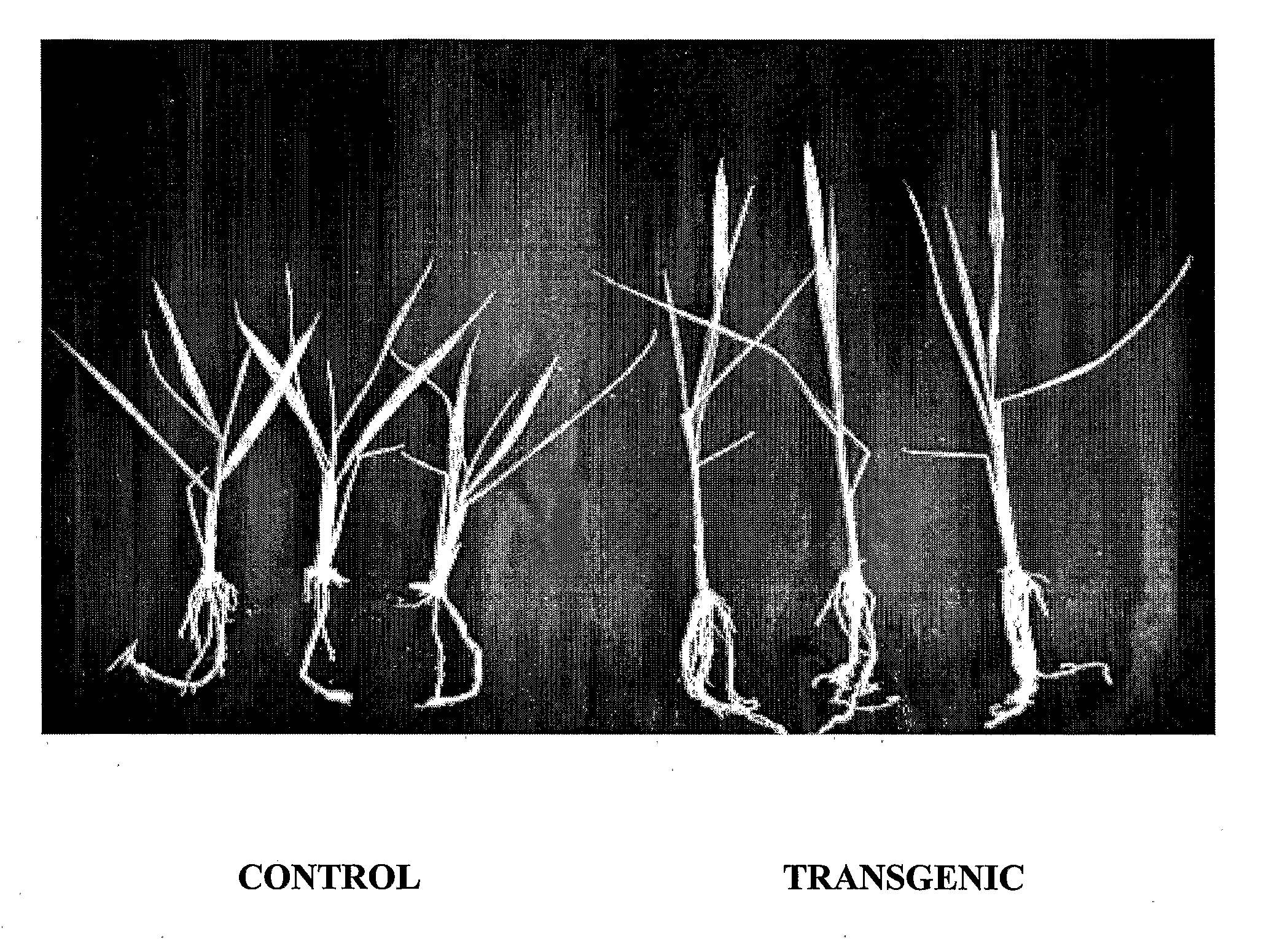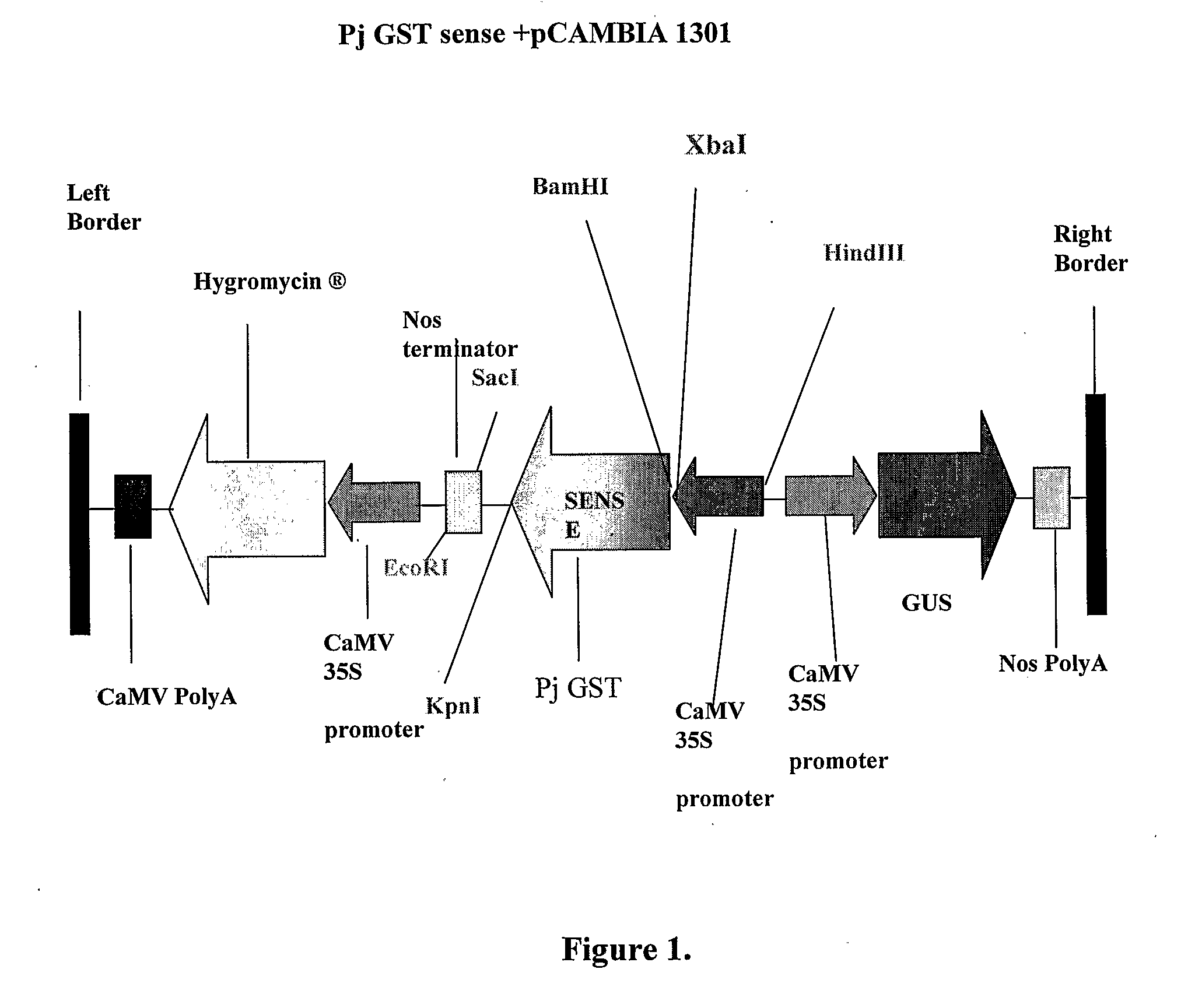Glutathione-s-transferase gene from proposis juliflora confers abiotic stress tolerance in plants
a technology of abiotic stress tolerance and a gene, which is applied in the field of pjgst gene from prosopis juliflora, can solve the problems of crop yield decline, crop yield decline, and crop yield decline, and achieve the effect of increasing tolerance to drought and salt stress
- Summary
- Abstract
- Description
- Claims
- Application Information
AI Technical Summary
Benefits of technology
Problems solved by technology
Method used
Image
Examples
example 1
[0061]Plant growth conditions and RNA isolation
[0062]Two-month old Prosopis plants were put under drought stress by with-holding water for 21 days. The relative water content (RWC) of control plants and drought stressed plants were measured according to the formula:
RWC %={(fresh weight-dry weight) / (turgid weight-dry weight)}100
[0063]The RWC of control was found to be 95.5% and treated plants were found to be 70.4%. Total RNA was isolated from the water stressed plant leaves by the method of Chomczynski and Sacchi (1987). Leaf tissue was harvested from pooled plants and five grams of tissue was macerated in liquid nitrogen and suspended in 18 ml of RNA extraction buffer. To the slurry, 1.8 ml of 2 M sodium acetate (pH 4.0), 18 ml of water saturated phenol and 3.6 ml of 49:1 chloroform: isoamyl alcohol were sequentially added and mixed by inversion. The contents were mixed and cooled on ice for 15 minutes. Finally, the suspension was centrifuged at 10,000×g for 10 minutes at 4° C. Aft...
example 2
[0064]Construction of a eDNA library
[0065]A cDNA library is a collection of cDNAs obtained from mRNAs expressed in a particular cell or tissue. A cDNA library was constructed using lug of DNase I treated mRNA by using modified Oligo (dT) primer, CDS III / 3′ PCR primer as shown in SEQ ID NO: 5 that primes the first strand synthesis reaction. The oligogonucleotide as shown in SEQ ID NO: 6 serve as a short extended template at the 5′ end of the mRNA. When the RT reaches the 5′ end of the template mRNA, the enzymes terminal transferse activity adds a few additional nucleotides, primarily deoxycytidine, to the 3′ end of the cDNA. The oligogonucleotide (as shown in SEQ ID NO: 6) which has an oligo (G) sequence at its 3′ end, base pairs with the deoxycytidine stretch, creating an extended template. Reverse transcriptase then switches templates and continues replicating to the end of the oligonucleotide. The resulting single stranded cDNA contains the sequence complementary to the oligogonuc...
example 3
[0066]PjGST Expression Kinetics in Response to Abiotic Stresses
[0067]To study the effect of water, osmotic, salinity and heat stress on the expression of the PjGST gene northern analysis ( FIG. 3) was performed using total RNA, isolated from mannitol (800 mM) , salt (500 mM), PEG 8000 (25%) and heat (50° C., 60 minutes) stressed Prosopis juliflora leaves. Total RNA (30 ug) was separated on 1.4% formaldehyde gel and transferred to nylon membranes (Sambrook et al. 1989). After transfer, the membrane was baked at 80° C. for 1 hour. A PCR amplified fragment of the selected cDNA clones such as PjGST (SEQ ID NO: 2) was used as the hybridization probe. Prehybridization was carried out for three hours in prehybridization buffer at 42° C. in 50% formamide, 6×SSC (1× being 0.15 M NaCl, 0.015M sodium citrate) 25 mM sodium phosphate buffer pH 6.5, 10× Denliardt's solution and 250 ug / ml of denatured salmon sperm DNA. Following hybridizations (Sambrook et al. 1989), the blot was washed with 1×SSC...
PUM
| Property | Measurement | Unit |
|---|---|---|
| Relative Water Content | aaaaa | aaaaa |
| Relative Water Content | aaaaa | aaaaa |
| abiotic stress tolerance | aaaaa | aaaaa |
Abstract
Description
Claims
Application Information
 Login to View More
Login to View More - R&D Engineer
- R&D Manager
- IP Professional
- Industry Leading Data Capabilities
- Powerful AI technology
- Patent DNA Extraction
Browse by: Latest US Patents, China's latest patents, Technical Efficacy Thesaurus, Application Domain, Technology Topic, Popular Technical Reports.
© 2024 PatSnap. All rights reserved.Legal|Privacy policy|Modern Slavery Act Transparency Statement|Sitemap|About US| Contact US: help@patsnap.com










